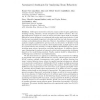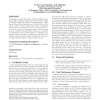64 search results - page 12 / 13 » An Approach for the Design of Self-conscious Agent for Robot... |
ATAL
2005
Springer
13 years 11 months ago
2005
Springer
Reinforcement learning problems are commonly tackled with temporal difference methods, which use dynamic programming and statistical sampling to estimate the long-term value of ta...
AAMAS
2004
Springer
13 years 6 months ago
2004
Springer
Multi-agent teamwork is critical in a large number of agent applications, including training, education, virtual enterprises and collective robotics. The complex interactions of ag...
GECCO
2007
Springer
13 years 10 months ago
2007
Springer
The development of coherent and dynamic behaviors for mobile robots is an exceedingly complex endeavor ruled by task objectives, environmental dynamics and the interactions within...
GECCO
2008
Springer
13 years 7 months ago
2008
Springer
In this paper we apply three Neuro-Evolution (NE) methods as controller design approaches in a collective behavior task. These NE methods are Enforced Sub-Populations, MultiAgent ...
AI
2005
Springer
13 years 6 months ago
2005
Springer
A theoretical framework for grounding language is introduced that provides a computational path from sensing and motor action to words and speech acts. The approach combines conce...


